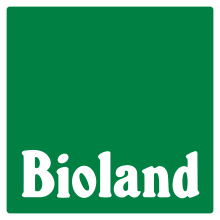You can help expand this article with text translated from the corresponding article in German. (June 2013) Click for important translation instructions.
|
 | |
| Founded | 1971; 54 years ago (1971) |
|---|---|
| Founder | 12 farmer families, including Hans and Maria Müller |
| Type | Registered association |
| Focus | Organic movement |
| Origins | Based on 1951 theories of Dr. Hans Müller and Dr. Hans Peter Rusch |
| Method | Certification |
| Members | 5719 farmers, 989 business partners |
| Key people | Jan Plagge (president) |
| Website | www |
Bioland is the largest organic-food association in Germany. Its organic certification standards exceed EU minimum requirements.
History
During the 1920s, a number of agricultural movements began with the goal of countering the effect of industrialization and globalization on food production. One of these was the Jungbauernbewegung (or Bauernheimatbewegung, "farmer heimat movement") farmer movement, which influenced Bioland.
The Jungbauernbewegung was founded in 1923 in Grosshöchstetten to provide poor Swiss farmers with agricultural techniques requiring only local resources. Its founder, Hans Müller, was an accredited botanist and high-school teacher who joined the Swiss parliament in 1929. His farmer-oriented party gathered 13.8 percent of the parliamentary vote in the 1938 elections. When the party dissolved in 1946, Müller turned to agriculture. With his wife Maria and German physician Hans Peter Rusch, Müller began developing agricultural theories based on a closed, organic cycle.
In 1951 they invited other farmers to their Möschberg farm to demonstrate the success of their methods, which had been adopted by a number of farmers in southern Germany. In subsequent years, similar meetings were held at Möschberg. In 1971 the Scharf, Colsman, Sippel, Rinklin, Wenz, Müller, Teschemacher, Hoops and Müller farm families founded a bio-gemüse (organic vegetable) association based on an initiative by Rusch.
The original 12 founders developed formal guidelines for organic-vegetable production, which were published in 1972. In 1974, the association was renamed Fördergemeinschaft organisch-biologischer Landbau e.V.. At first, it used the brand name Dr. Müller Bio Gemüse for products sold in Reformhaus food stores. In 1978, the certification trademark Bioland was registered. A number of regional Bioland associations were founded throughout Germany.
Certification
When the EU harmonized standards for organic food production, the older organic food associations criticized the new standards as weaker than existing guidelines. After the resolution of the EU organic-food recommendation, the associations brought their standards in line with the EU's so any Bioland-certified organic food would meet the requirements for EU organic-food (although Bioland's requirements exceed those of the EU).
Bio mit Gesicht initiative
The Bioland association and subsidiaries, like the Bioland market, are members of the Bio mit Gesicht initiative which increases transparency in organic-food production. Organic products may have a "BMG" number, which can be entered on a website showing the farm and farmer. The idea parallels an EU initiative where all eggs must bear a number which can be entered on a website for details of their origin. Only the address of the farm was initially shown, but the website was updated to include photos as well. While the egg number is regulated by European law, the BMG number is voluntary. Notable organic-food associations include Bioland, Naturland and Demeter International (Demeter). The Bio mit Gesicht association shares an address with the German branch of the Research Institute of Organic Agriculture (FIBL), which is based on a Swiss initiative (Bio Suisse organic certification).
References
- ^ (in German) Zahlen, Daten, Fakten: Die Bio-Branche 2013 Archived 19 August 2014 at the Wayback Machine, at boelw.org (PDF; 32 pages, 6.8 MB, 12. Februar 2013). Retrieved 24 June 2014.
- "Bioland". ecolabelindex.com. Retrieved 10 February 2014.
- "GERMANY: Schill Malz now produces according to Bioland standards". schillmalz.com. Archived from the original on 22 February 2014. Retrieved 10 February 2014.

